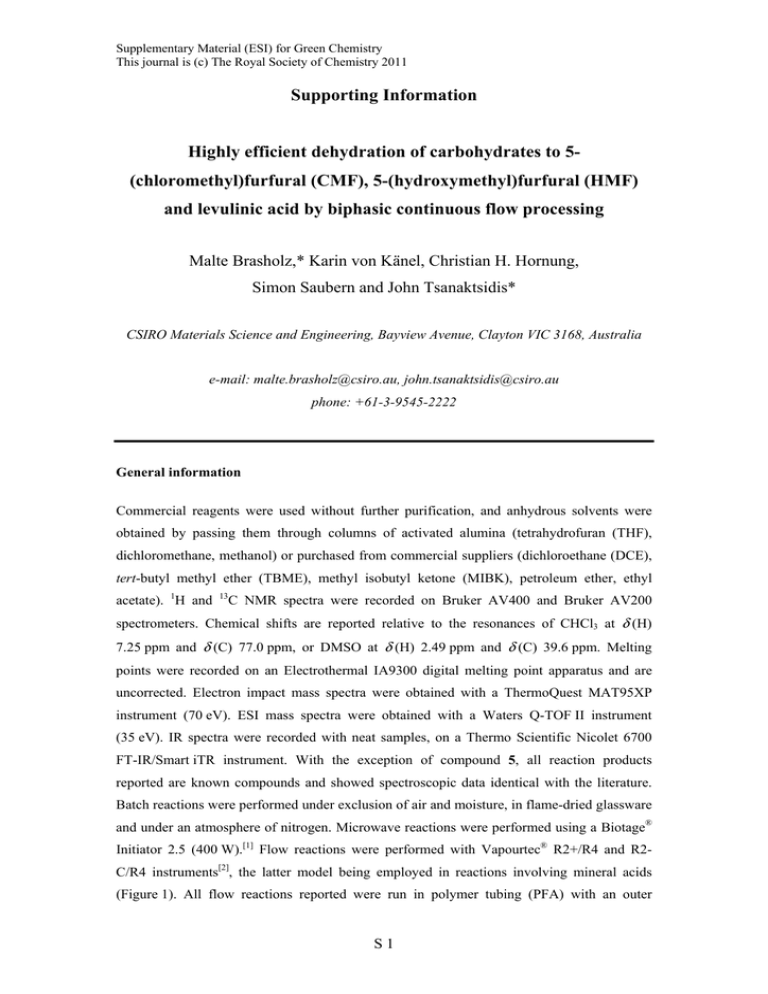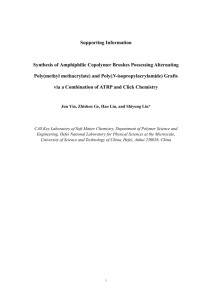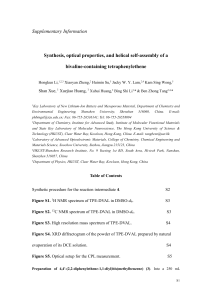(chloromethyl)furfural (CMF), 5
advertisement

Supplementary Material (ESI) for Green Chemistry This journal is (c) The Royal Society of Chemistry 2011 Supporting Information Highly efficient dehydration of carbohydrates to 5(chloromethyl)furfural (CMF), 5-(hydroxymethyl)furfural (HMF) and levulinic acid by biphasic continuous flow processing Malte Brasholz,* Karin von Känel, Christian H. Hornung, Simon Saubern and John Tsanaktsidis* CSIRO Materials Science and Engineering, Bayview Avenue, Clayton VIC 3168, Australia e-mail: malte.brasholz@csiro.au, john.tsanaktsidis@csiro.au phone: +61-3-9545-2222 General information Commercial reagents were used without further purification, and anhydrous solvents were obtained by passing them through columns of activated alumina (tetrahydrofuran (THF), dichloromethane, methanol) or purchased from commercial suppliers (dichloroethane (DCE), tert-butyl methyl ether (TBME), methyl isobutyl ketone (MIBK), petroleum ether, ethyl acetate). 1H and 13 C NMR spectra were recorded on Bruker AV400 and Bruker AV200 spectrometers. Chemical shifts are reported relative to the resonances of CHCl3 at δ (H) 7.25 ppm and δ (C) 77.0 ppm, or DMSO at δ (H) 2.49 ppm and δ (C) 39.6 ppm. Melting points were recorded on an Electrothermal IA9300 digital melting point apparatus and are uncorrected. Electron impact mass spectra were obtained with a ThermoQuest MAT95XP instrument (70 eV). ESI mass spectra were obtained with a Waters Q-TOF II instrument (35 eV). IR spectra were recorded with neat samples, on a Thermo Scientific Nicolet 6700 FT-IR/Smart iTR instrument. With the exception of compound 5, all reaction products reported are known compounds and showed spectroscopic data identical with the literature. Batch reactions were performed under exclusion of air and moisture, in flame-dried glassware and under an atmosphere of nitrogen. Microwave reactions were performed using a Biotage® Initiator 2.5 (400 W).[1] Flow reactions were performed with Vapourtec® R2+/R4 and R2C/R4 instruments[2], the latter model being employed in reactions involving mineral acids (Figure 1). All flow reactions reported were run in polymer tubing (PFA) with an outer S1 Supplementary Material (ESI) for Green Chemistry This journal is (c) The Royal Society of Chemistry 2011 diameter of 1/16 inch and 1 mm inner diameter. Reactions on preparative scale were generally run in fully continuous (“steady state”) mode. Figure 1: Vapourtec R2+/R4 flow reactor system.[2] Where indicated, a particle filter was connected to the flow reactor outlet, positioned before the back pressure regulator. The filter consisted of a modified Omnifit® column[3] (10 mm bore, 100 mm length) as shown in Figure 2. Figure 2: Particle filter for continuous flow reactions. S2 Supplementary Material (ESI) for Green Chemistry This journal is (c) The Royal Society of Chemistry 2011 Continuous flow conversion of D-glucose into CMF, 5-(chloromethyl)furan-2- 8b ar carbaldehyde (1) A solution of D-glucose (200 mg, 1.11 mmol) in 32% aqueous HCl (10 mL) was pumped at a rate of 1 mL/min into a T-piece where it was mixed with DCE, pumped at the same rate in a second flow channel. The combined flow stream was directed through a 10 mL flow coil and heated to 120 °C. The flow stream was directed through a particle filter (positioned before the 8 bar acid resistant back pressure regulator) and the product mixture was collected at the reactor outlet. The layers were separated and the aqueous layer was extracted with CH2Cl2 (3 ×). The combined organic layers were dried with MgSO4, filtered and evaporated. The crude product was filtered through silica gel with the aid of CH2Cl2 to afford, after evaporation and drying in high vacuum, 93 mg of 1 (58%) as a yellowish oil (purity >95% by 1 H NMR). 1 H NMR (CDCl3, 400 MHz): 4.59 (s, 2 H, CH2), 6.56 (d, J = 3.6 Hz, 1 H, Ar-H), 7.18 (d, J = 3.6 Hz, 1 H, Ar-H), 9.60 (s, 1 H, CHO) ppm. 13C NMR (CDCl3, 100 MHz): 36.5 (t, CH2), 111.9, 121.7 (2 d, Ar), 152.8, 156.0 (2 s, Ar), 177.7 (s, CHO) ppm. Spectroscopic data are in agreement with the literature.[4] 8b ar Continuous flow conversion of D-fructose into CMF (1) on 10 gram scale A solution of D-fructose (10.00 g, 55.51 mmol) in 32% aqueous HCl (100 mL) was pumped at a rate of 5 mL/min into a T-piece where it was mixed with CH2Cl2, pumped at the same S3 Supplementary Material (ESI) for Green Chemistry This journal is (c) The Royal Society of Chemistry 2011 rate in a second flow channel. The combined flow stream was directed through a 10 mL flow coil and heated to 100 °C. The flow stream was directed through a particle filter (positioned before the 8 bar acid resistant back pressure regulator) and the product mixture was collected at the reactor outlet. The layers were separated and the aqueous layer was extracted with CH2Cl2 (3 ×). The combined organic layers were dried with MgSO4, filtered and evaporated. The crude product was filtered through silica gel with the aid of CH2Cl2 to afford, after evaporation and drying in high vacuum, 6.32 g of 1 (79%) as a yellowish oil (purity >95% by 1 H NMR). 8b ar Continuous flow conversion of sucrose into CMF (1) on 10 gram scale A solution of sucrose (10.00 g, 29.21 mmol, equivalent of 58.43 mmol monosaccharide) in 32% aqueous HCl (100 mL) was pumped at a rate of 5 mL/min into a T-piece where it was mixed with DCE, pumped at the same rate in a second flow channel. The combined flow stream was directed through a 10 mL flow coil and heated to 130 °C. The flow stream was directed through a particle filter (positioned before the 8 bar acid resistant back pressure regulator) and the product mixture was collected at the reactor outlet. The layers were separated and the aqueous layer was extracted with CH2Cl2 (3 ×). The combined organic layers were dried with MgSO4, filtered and evaporated. The crude product was filtered through silica gel with the aid of CH2Cl2 to afford, after evaporation and drying in high vacuum, 5.13 g of 1 (61%) as a yellowish oil (purity >95% by 1H NMR). S4 Supplementary Material (ESI) for Green Chemistry This journal is (c) The Royal Society of Chemistry 2011 10 0p si 5-(Hydroxymethyl)furan-2-carbaldehyde (2) A solution of CMF 1 (1.45 g, 10.00 mmol) in THF (20 mL) was pumped at a rate of 2 mL/min into a T-piece where it was mixed with H2O, pumped at the same rate in a second flow channel. The combined flow stream was directed through a 10 mL flow coil and heated to 100 °C. The product mixture was collected at the reactor outlet, diluted with H2O and made basic with 2.5 M aq. NaOH (pH ~ 12). The mixture was extracted 5 × with CH2Cl2. Drying of this extract over MgSO4, filtration and evaporation furnished 0.89 g of 2 (71%) as a yellow oil (purity >95% by 1H NMR). The aqueous layer was brought to pH ~ 1 with 32% aq. HCl, saturated with NaCl and extracted with EtOAc (7 ×). Drying of this extract over MgSO4, filtration and evaporation furnished 0.23 g of levulinic acid 6 (20%) as a colorless oil (purity >95% by 1H NMR). HMF 2: 1H NMR (CDCl3, 400 MHz): 3.57 (br. s, 1 H, OH), 4.65 (s, 2 H, CH2), 6.47 (d, J = 3.5 Hz, 1 H, Ar-H), 7.18 (d, J = 3.5 Hz, 1 H, Ar-H), 9.50 (s, 1 H, CHO) ppm. 13 C NMR (CDCl3, 100 MHz): 57.4 (t, CH2), 110.0, 123.2 (2 d, Ar), 152.2, 161.0 (2 s, Ar), 177.8 (s, CHO) ppm. Spectroscopic data are in agreement with the literature.[5] Furan-2,5-dicarboxylic acid (3) CMF 1 (154 mg, 1.07 mmol) was dissolved in 69% aqueous HNO3 (1 mL) and the mixture was stirred at 80 °C for 24 h. A colorless solid precipitated and gas evolution had ceased after that period of time. The liquid was evaporated under reduced pressure and the remaining solid S5 Supplementary Material (ESI) for Green Chemistry This journal is (c) The Royal Society of Chemistry 2011 was dried in high vacuum to afford 98 mg of 3 (59%) as a colorless solid (purity ~95% by 1H NMR and mass spectrometry). M.p. > 300 °C. 1H NMR (DMSO-d6, 400 MHz): 7.27 (s, 2 H, Ar-H), 13.05 (br. s, 2 H, COOH) ppm. 13C NMR (DMSO-d6, 50 MHz): 118.6 (d, Ar), 147.3 (s, Ar), 159.2 (s, COOH) ppm. Spectroscopic data are in agreement with the literature.[6] (5-Methylfuran-2-yl)methanol (4) A solution of NaBH4 (1.40 g, 37.00 mmol) in H2O (30 mL) was added dropwise (over a period of 15 min) at 5 °C to a solution of CMF 1 (1.78 g, 12.30 mmol) and tributylhexadecylphosphonium bromide (624 mg, 1.23 mmol) in tert-butyl methyl ether (TBME, 30 mL). The mixture was stirred vigorously for 2 h at R.T., then the layers were separated. The aqueous layer was extracted with Et2O (3 ×) and the combined organic layers were dried over MgSO4, filtered and evaporated. Filtration of the residue through silica gel with 1:3 EtOAc/PET afforded 1.01 g of 4 (73%) as a colorless liquid. 1 H NMR (CDCl3, 400 MHz): 2.25 (s, 3 H, CH3), 2.54 (br. s, 1 H, OH), 4.48 (s, 2 H, CH2), 5.88 (dd, J = 1.0, 3.1 Hz, 1 H, Ar-H), 6.12 (d, J = 3.1 Hz, 1 H, Ar-H) ppm. 13C NMR (CDCl3, 100 MHz): 13.4 (q, CH3), 57.2 (t, CH2), 106.1, 108.6 (2 d, Ar), 152.15, 152.24 (2 s, Ar) ppm. Spectroscopic data are in agreement with the literature.[7] N,N'-[Furan-2,5-diylbis(methylene)]bis(1-phenylmethanamine) (5) Et3N (80 μL, 0.57 mmol) and benzylamine (160 μL, 1.46 mmol) were added to a mixture of CMF 1 (65 mg, 0.45 mmol) and 4 Å molecular sieves (100 mg) in DCE (2 mL). After 16 h of S6 Supplementary Material (ESI) for Green Chemistry This journal is (c) The Royal Society of Chemistry 2011 stirring at R.T., NaBH(OAc)3 (224 mg, 1.06 mmol) and HOAc (51 μL, 0.90 mmol) were added and stirring was continued for 16 h at R.T. The mixture was filtered and the filtrate was poured onto NaHCO3 aq. The mixture was extracted with EtOAc (5 ×) and the organic layer was dried over MgSO4, filtered and evaporated. Column chromatography (silica gel, EtOAc, then 1:10 MeOH/CH2Cl2) afforded 85 mg of 5 (62%) as a yellow oil. IR (neat): 2920, 1495, 1450, 1260, 1015, 790, 735 cm–1. 1H NMR (CDCl3, 400 MHz): 1.86 (br. s, 2 H, NH), 3.76, 3.79 (2 s, 2 × 2 H, 2 × CH2), 6.11 (s, 2 H, Ar-H), 7.22-7.35 (m, 10 H, Ph) ppm. 13 C NMR (100 MHz, CDCl3): 45.5, 52.8 (2 t, CH2), 107.7 (d, Ar), 127.0, 128.2, 128.4 (3 d, Ph), 139.8 (s, Ph), 153.0 (s, Ar) ppm. MS (EI) m/z (%): 306 [M] +• (1), 305 (2), 251 (2), 199 (25), 106 (15), 94 (20), 91 (100). HRMS (ESI) m/z: found 329.1616, C20H22N2ONa [M+Na]+• calc. 329.1630. 8b ar Continuous flow conversion of D-fructose into HMF (2) D-Fructose (1.00 g, 5.55 mmol) was dissolved in 0.25 M aq. HCl (10 mL) and pumped at a rate of 0.33 mL/min into a T-piece where it was mixed with MIBK (methyl isobutyl ketone), pumped at a rate of 1.00 mL/min, in a second flow channel. The combined flow stream was directed through a 20 mL flow coil and heated to 140 °C. The flow stream was directed through an 8 bar acid resistant back pressure regulator and the product mixture was collected at the reactor outlet. The layers were separated and the aqueous layer was extracted with EtOAc (5 ×), then, NaCl was added, followed by 2 further EtOAc extractions. The combined organic layers were dried with MgSO4, filtered and evaporated. The crude product (0.56 g) consisted of HMF 2 along with levulinic acid 6 in a ratio of 87:13 (by 1H NMR integration), with less than 3% of other side products. Filtration through a short plug of silica gel with the aid of EtOAc afforded, after evaporation and drying in high vacuum, 0.52 g of 2 (74%) as an orange liquid (purity >95% by 1H NMR). S7 Supplementary Material (ESI) for Green Chemistry This journal is (c) The Royal Society of Chemistry 2011 16 ba r Continuous flow conversion of D-fructose into levulinic acid (6) A solution of D-fructose (1.00 g, 5.55 mmol) in 2 M aqueous HCl (3.30 mL) and MeOH (6.70 mL) was pumped into a 10 mL flow coil, at a rate of 0.13 mL/min, and the reactor was heated to 140 °C. The flow stream was directed through a particle filter, positioned before the back pressure regulator (16 bar, acid resistant), and the product mixture was collected at the reactor outlet. The mixture was diluted with H2O and made basic with 2.5 M aq. NaOH (pH ~ 12). The mixture was extracted 5 × with CH2Cl2 (drying of this extract over MgSO4, filtration and evaporation furnished 0.08 g of HMF 2, 11%). The aqueous layer was brought to pH ~ 1 with 32% aq. HCl, saturated with NaCl and extracted with EtOAc (7 ×). The combined organic layers were dried with MgSO4, filtered, evaporated and finally filtered through a short column of neutral alumina with 1:10:100 HOAc/MeOH/CH2Cl2 to afford, after evaporation, 0.46 g of 6 (72%) as an oil (purity >95% by 1H NMR). LA 6: 1H NMR (CDCl3, 400 MHz): 2.19 (s, 3 H, CH3), 2.62, 2.74 (2 t, J = 6.8 Hz, 2 × 2 H, 2 × CH2), 10.60 (br. s, 1 H, COOH) ppm. 13C NMR (CDCl3, 100 MHz): 27.7 (q, CH3), 29.8, 37.7 (2 t, 2 × CH2), 178.5 (s, COOH), 206.8 (s, CO) ppm. Spectroscopic data are in agreement with the literature.[8] References [1] www.biotage.com [2] www.vapourtec.co.uk [3] www.omnifit.com [4] K. Sanda, L. Rigal, M. Delmas, A. Gaset, Synthesis 1992, 541. [5] C. Li, Z. Zhang, Z. K. Zhao, Tetrahedron Lett. 2009, 50, 5403. [6] W. Partenheimer, V. V. Grushin, Adv. Synth. Catal. 2001, 343, 102. [7] M. E. Jung, G.-Y. J. Im, J. Org. Chem. 2009, 74, 8739. [8] P. V. Bernhardt, R. M. Carman, T. T. Le, Aust. J. Chem. 2007, 60, 354. S8






